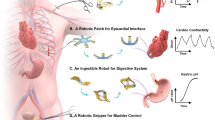Abstract
This article introduces a new type of transducer that combines capacitive pressure sensing techniques with biosensitive hydrogels, using an adaptable MEMS fabrication platform. Hydrogel swelling in response to analyte concentration exerts contact pressure on a deformable conducting diaphragm, producing a capacitance change. Initial results are reported for testing device feasibility. Uncrosslinked PHEMA hydrogel was tested for swelling pressure in response to calcium nitrate tetrahydrate. Diaphragm deflection due to applied air pressure was measured on NiTi-based diaphragms and compared with hydrogel-actuated deflections of the same diaphragms to determine the pressure generating characteristics of the hydrogel. The PHEMA sample exhibited greatest sensitivity in the concentration range 0–0.5 M, generating an average of 110 mN/M/μl. The device was incorporated into a passive LC resonant circuit. Resonance frequency was measured as a function of applied air pressure, in the range of pressures generated by hydrogel swelling. Resonance frequency shifted from 66 MHz to 33 MHz over the pressure range 0–32 kPa, corresponding to an estimated average sensitivity of 66 Hz per μmol of calcium nitrate tetrahydrate over the range 0–0.5 M.
Similar content being viewed by others
References
P. Arquint, A. van den Berg, D.J. Strike, N.F. de Rooij, and M. Koudelka-Hep, Journal of Biomaterials Applications 7, 47 (1992).
D.J. Beebe et al., Nature 404, 588 (2000).
L. Brannon-Peppas and N.A. Peppas, Chemical Engineering Science 46, 715 (1991).
S. Chatzandroulis, D. Tsoukalas, and P.A. Neukomm, Journal of Microelectromechanical Systems 9, 18 (2000).
C.C. Collins, IEEE Transactions on Bio-Medical Engineering BME-14, 74 (1967).
P. Eun-Chul, Y. Jun-Bo, and Y. Euisik, Japanese Journal of Applied Physics 37, 7124 (1998).
W. Gombotz and A. Hoffman, in Hydrogels in Medicine and Pharmacy Volume I, edited by N.A. Peppas (CRC Press, Boca Raton, 1986), p. 95.
D.E. Gregonis, C.M. Chen, and J.D. Andrade, in Hydrogels for medical and related applications, edited by J.D. Andrade (American Chemical Society, Washington, 1976), p. 89.
C.A. Grimes, D. Kouzoudis, K.G. Ong, and R. Crump, Biomedical Microdevices 2, 51-60 (1999).
C. Guoping, Y. Imanishi, and Y. Ito, Langmuir 14, 6610 (1998).
M. Husak, Journal of Micromechanics and Microengineering 7, 173 (1997).
A. Kikuchi et al., Analytical Chemistry 68, 823 (1996).
S. Lee and K. Park, in Hydrogels and biodegradable polymers for bioapplications, edited by R. Ottenbrite (American Chemical Society, Washington, DC, 1996), p. 1.
T. Miyata, N. Asami, and T. Uragami, Nature 399, 766 (1999).
K. O'Driscoll, A. Kapoulas, A. Albisser, and R. Gander, in Hydrogels for medical and related applications, edited by J. Andrade (American Chemical Society, Washington, DC, 1976), p. 162.
H. Park and K. Park, in Hydrogels and Biodegradable Polymers for Bioapplications, edited by R.M. Ottenbrite, S.J. Huang, and K. Park (American Chemical Society, Washington, DC 1996), p. 1.
B. Puers, A. Vandenbossche, E. Peeters, and W. Sansen, Sensors and Actuators A 23, 944 (1990).
B. Ratner and A. Hoffman, in Hydrogels for medical and related applications, edited by J. Andrade (American Chemical Society, Washington, DC, 1976), pp. 1-36.
L. Rosengren, P. Rangsten, Y. Backlund, and B. Hok, Sensors and Actuators A 43, 55 (1994).
T. Sawai, H. Shinohara, Y. Ikariyama, and M. Aizawa, Journal of Electroanalytical Chemistry 297, 399 (1991).
T. Schalkhammer, C. Lobmaier, F. Pittner, A. Leitner, H. Brunner, and F.R. Aussenegg, Sensors and Actuators B 24-25, 166 (1995).
U. Schnakenberg, P. Walter, G. vom Bogel, C. Kruger, H.C. Ludtke-Handjery, H.A. Richter, W. Specht, P. Ruokonen, and W. Mokwa, Sensors and Actuators A 85, 287 (2000).
N.F. Sheppard, Jr., M.J. Lesho, P. McNally, and A.S. Francomacaro, Sensors and Actuators B 28, 95 (1995).
R. Siegel and B. Firestone, Macromolecules 21, 3254 (1988).
Author information
Authors and Affiliations
Rights and permissions
About this article
Cite this article
Strong, Z.A., Wang, A.W. & McConaghy, C.F. Hydrogel-Actuated Capacitive Transducer for Wireless Biosensors. Biomedical Microdevices 4, 97–103 (2002). https://doi.org/10.1023/A:1014627029818
Issue Date:
DOI: https://doi.org/10.1023/A:1014627029818




